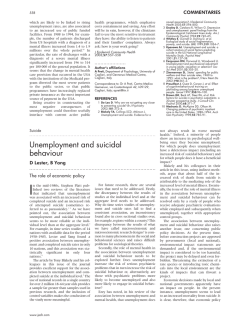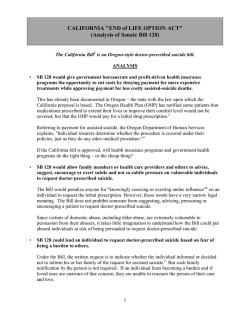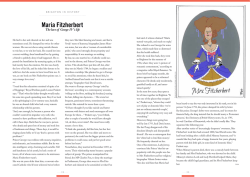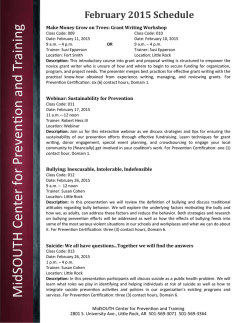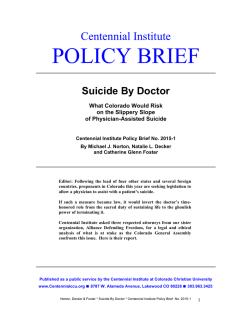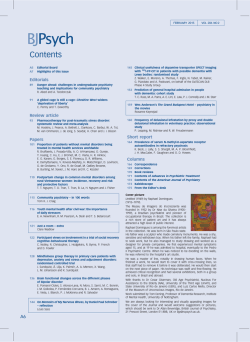
Download [ PDF ] - journal of evidence based medicine and
ORIGINAL ARTICLE SUICIDAL HANGING IN URBAN YOUTH: A PROSPECTIVE STUDY Bhola Kumar Singh1 HOW TO CITE THIS ARTICLE: Bhola Kumar Singh. ”Suicidal Hanging in Urban Youth: A Prospective Study”. Journal of Evidence based Medicine and Healthcare; Volume 2, Issue 6, February 9, 2015; Page: 602-607. ABSTRACT: BACKGROUND: Suicide is among the top three causes of death among youth worldwide. Hanging is among the most common modes of suicide. OBJECTIVES: The purpose of this prospective study is to determine the Suicidal hanging in urban youth and determine the prevalence of suicidal hanging in our community. METHODS: In this descriptive, prospective, cross sectional study, all patients who presented to the department of emergency medicine with suicidal hanging during this study period of 12 months from January 2010-December 2011 in. were included. RESULTS: Total number of males in the study is 32 (64%), females in the study is 18(36%). Mean age of the youth was 22.50±8.15(SD) years, Male 18.50±12.15(SD) years, Females 20.50±5.25(SD) years; predominantly the patients were in the age group of 22-26 years. Number of male smokers in the study was 26 (81.25%) female smokers were 4(22.22%), number of male alcoholics were 27(84.37%) whereas female alcoholics were 6(33.33%), number of patients with pallor in males were 16(50%) whereas females with pallor were 12(66.66%), number of males with skin changes were 6(18.75%) when compared to females who had 8(44.44%) skin changes, number of males wit oedema were 4(12.5%) and 6(33.33%) of females had oedema, the mean weight among males were 48±8.34kgs when compared to females which was 42±6.56kgs. Most of the patients who attempted suicide had varied personality issues from mood disorders to psychosis. CONCLUSION: There is significant percentage of patients who attempt suicide by hanging. KEYWORDS: Psychosis, Mood disorders, Suicidal hanging, urban youth. INTRODUCTION: Suicide is among the top three cause of death among youth worldwide. According to the WHO, every year, almost one million people die from suicide and 20 times more people attempt suicide; a global mortality rate of 16 per 100,000, or one death every 40 seconds and one attempt every 3 seconds, on average. Suicide worldwide was estimated to represent 1.8% of the total global burden of disease in 1998; in 2020, this figure is projected to be 2.4% in countries with market and former socialist economies. According to the most recent World Health Organization (WHO) data that was available as of 2011.1 Hanging is one of the most reliable methods of suicide, as for firearms, it is not 100% effective - studies would suggest 77% - 88% effective 2 Suicide by hanging is the next most frequent method in India.3-5 The profile of victims comprises married females or unmarried males in the age group of 21-30 years, faced with stressors in the form of unemployment, harassment for dowry, prolonged illness, failure in examinations, financial duress, or interpersonal problems.6 MATERIALS & METHODS: STUDY DESIGN: Prospective, cross sectional study. J of Evidence Based Med & Hlthcare, pISSN- 2349-2562, eISSN- 2349-2570/ Vol. 2/Issue 6/Feb 09, 2015 Page 602 ORIGINAL ARTICLE SAMPLE SIZE: 50 cases over a span of 12 months from January 2010-December 2010 in. were included. METHOD OF COLLECTION OF DATA: The data for the purpose of the study was collected in a predesigned and pretested proforma which include various socioeconomic parameters like age, sex, occupation, religion, etc. About 50 cases were selected on the basis of the simple random sampling method. The statistically data was analyzed with the help of software SPSS.16.0, ANOVA, factor analysis and Chi-square test INCLUSION CRITERIA: Patients with attempted complete Suicidal hanging. EXCLUSION CRITERIA: Patients with incomplete suicidal hanging, strangulation or other methods of suicide. Questionnaires, physical, radiographic examination was done in all patients. RESULTS: Table 1 shows total number of males in the study is 32(64%), females in the study is 18 (36%). Mean age of the youth was 22.50±8.15(SD) years, Male 18.50±12.15(SD) years, Females 20.50 ± 5.25 (SD) years. Table 2 shows predominantly the patients were in the age group of 22-26 years. Number of patients in the age group 16-18 years was 7(14%), 19-21years was 9(18%), 22-24 years was 16(32%), number of patients in 25-27 years was 11(22%) and number of patients in the age group 27-29 years was 7(14%). Table 3 shows number of male smokers in the study was 26(81.25%) female smokers were 4(22.22%). Table 4 shows number of male alcoholics was 27(84.37%) whereas female alcoholics were 6(33.33%). Table 5 shows number of patients with pallor in males were 16(50%) whereas females with pallor were 12(66.66%), number of males with skin changes were 6(18.75%) when compared to females who had 8(44.44%) skin changes, number of males wit oedema were 4(12.5%) and 6(33.33%) of females had oedema. Table 6 shows the mean weight among males were 48±8.34kgs when compared to females which was 42±6.56kgs. Most of the patients who attempted suicide had varied personality issues from mood disorders to psychosis. All the patients were from lower middle class. The educational level of all patients was between class8 to class 12. DISCUSSION: Suicide by hanging has increased in India and a number of other countries over the last 30 years. Hanging is a highly lethal method of suicide in that around 70% of those who attempt suicide using this method die. It is to be noted that only half of those who die by hanging are found fully suspended with their feet above the ground. Ligature points used by those in J of Evidence Based Med & Hlthcare, pISSN- 2349-2562, eISSN- 2349-2570/ Vol. 2/Issue 6/Feb 09, 2015 Page 603 ORIGINAL ARTICLE prisons and hospitals are often below head height. Most hanging deaths occur in the communityonly around 10% occur in prisons and psychiatric hospitals. Improved pre-hospital and acute medical management of victims may have some impact on the current death toll as around 20% of those who die from hanging are found alive. Sociocultural factors undermine the veracity of these records. Suicide attempt is a punishable offence under the Indian Penal Code (IPC Section 309); this results in underreporting. Deaths in rural areas are certified by village headmen (“panchyatdars”) though all cases are investigated by the police. The process of registering a death is particularly inefficient in rural areas. Eventually, only about 25% of deaths are registered and only about 10% are medically certified.7,8 Although suicide rates were commonly highest among older adult males, rates among young people have been increasing. Young adults are a particularly vulnerable group and currently show the highest rates of suicide the world over. Suicide is responsible for 6% of all deaths among young people.9 An Indian study showed that the suicide rate was highest in the 15-29 years age group (38 per 100,000 population) followed by the 30-44 years group (34 per 100,000 population). Youth in the age group 15-29 years accounted for the largest proportion (34.5%) of suicides followed by those in the age group 30-44 years (34.2%). Other studies in India also indicate that young adults are at increased risk, with ages 20-24 years followed by 25-29 years showing the highest rates of suicide in a psychological autopsy study10 Globally, attempted suicide is commoner in women and completed suicide is commoner in 11 men. The male: female suicide ratio is 3.8, 3.9, 4.1, and 3.4 in Australia, Canada, the United States, and the UK, respectively12 and it is lower in Asian countries.13 In one study of attempted suicide in India, 55.5% were uneducated.14 In another study, 54% of suicide attempters had received high school education or higher.15Women attempting suicide tended to have a lower educational status compared to men.15 The suicide rate is generally reported to be higher in urban areas because of a variety of stressors related to living and working in cities, including overcrowding and social isolation. In India, during the year 2000, though the suicide rate for the country was 10.8, the rate in urban areas was slightly lower at 9.94. 16 There has since been an increase in urban suicide rates to 11.4% in 2005, around 13% in 2006 and 2007, and 12.1% to 12.5% in 2008 and 2009.17 Studies in recent years are consistent in this regard: suicide 10 and attempted suicide were more common in persons living in urban areas. Multiple suicide attempts of low intentionality and lethality are typically associated with maladaptive coping and impulsivity in personality disorders. The rate of personality disorders among those who attempt suicide in India ranges from 7 to 50% in various studies.18,19,20 The most fruitful approach to tackling the rise in hanging suicides may therefore be through population-based initiatives to reduce the popularity of this method. This may be achieved through working with the media to reduce the portrayal of fictional suicides by hanging and the reporting of hanging suicides. J of Evidence Based Med & Hlthcare, pISSN- 2349-2562, eISSN- 2349-2570/ Vol. 2/Issue 6/Feb 09, 2015 Page 604 ORIGINAL ARTICLE REFERENCES: 1. World Health Organization. Suicide rates per 100,000 by country, year and sex. [Last accessed on 2012 Mar 27]. Available from: http://www.who.int/mental_health/ prevention/suicide_rates/en/index.html . 2. Card JJ. "Lethality of suicidal methods and suicide risk: Two distinct concepts", Omega 5, 1974. NL Farberow and ES Shneidman, the Cry for Help, 1961. 3. Accidental Deaths and Suicides in India 2006. New Delhi: Ministry of Home Affairs, Government of India; 2008. National Crime Records Bureau. 4. Khan FA, Anand B, Devi MG, Murthy KK. Psychological autopsy of suicide-a cross-sectional study. Indian J Psychiatry. 2005; 47: 73–8. 5. Bhatia MS, Verma SK, Murty OP. Suicide notes: Psychological and clinical profile. Int J Psychiatry Med. 2006; 36: 163–70. 6. Nagendra Gouda M, Rao SM. Factors related to attempted suicide in Davanagere. Indian J Community Med. 2008; 33: 15–8. 7. Bhat M. Minneapolis, MI, United States: Centre for Population Analysis and Policy, Humphrey Institute of Public Affairs, University of Minnesota; 1991. Mortality from accidents and violence in India and China, Research Report 91-06-1 Vol. 7. 8. Ruzicka LT. Suicide in countries and areas of the ESCAP region. Asia Pac Popul J. 1998; 13: 55–74. 9. Patton GC, Coffey C, Sawyer SM, Viner RM, Haller DM, Bose K, et al. Global patterns of mortality in young people: A systematic analysis of population health data. Lancet. 2009; 374: 881–92. 10. Khan FA, Anand B, Devi MG, Murthy KK. Psychological autopsy of suicide-a cross-sectional study. Indian J Psychiatry. 2005; 47: 73–8. 11. Phillips MR, Yang G, Li S, Li Y. Suicide and the unique prevalence pattern of schizophrenia in mainland China: A retrospective observational study. Lancet. 2004; 364: 1062–8. 12. Desjarlais RE, Good B, Kleinman A. World mental health: Problems and priorities in lowincome countries. New York: Oxford University Press; 1995. Suicide. 13. Lester D. Suicide in an international perspective. Suicide Life Threat Behav. 1997; 27: 10411. 14. Srivastava MK, Sahoo RN, Ghotekar LH, Dutta S, Danabalan M, Dutta TK, et al. Risk factors associated with attempted suicide: A case control study. Indian J Psychiatry. 2004; 46: 338. 15. Sudhir Kumar CT, Mohan R, Ranjith G, Chandrasekaran R. Gender differences in medically serious suicide attempts: A study from south India. Psychiatry Res. 2006; 144: 79–86. 16. Accidental Deaths and Suicides in India. New Delhi: NCRB; 2000. 17. Accidental Deaths and Suicides in India 2007. New Delhi: Ministry of Home Affairs, Government of India; 2009. National Crime Records Bureau. 18. Latha KS, Bhat SM, D’Souza P. Suicide attempters in a general hospital unit in India: Their socio-demographic and clinical profile-emphasis on cross-cultural aspects. Acta Psychiatr Scand. 1996; 94: 26–30. J of Evidence Based Med & Hlthcare, pISSN- 2349-2562, eISSN- 2349-2570/ Vol. 2/Issue 6/Feb 09, 2015 Page 605 ORIGINAL ARTICLE 19. Chandra sekaran R, Gnanaseelan J, Sahai A, Swaminathan RP, Perme B. Psychiatric and personality disorders in survivors following their first suicide attempt. Indian J Psychiatry. 2003; 45: 45–8. 20. Gupta SC, Singh H, Trivedi JK. Evaluation of suicidal risk in depressives and schizophrenics: A 2-year follow-up study. Indian J Psychiatry. 1992; 34: 298–310. Group Number of patients Percentage (%) Males 32 64 Females 18 36 Total 50 100 Table 1: Showing prevalence of present study Age groups(yrs) No. Patients (%) Total (n=50) Male Female 7 0 16-18 7(14%) 19-21 9(18%) 8 1 22-24 16(32%) 9 7 25-27 11(22%) 4 7 27-29 7(14%) 4 3 Total 50 32 18 Table 2: Showing age and sex distribution according to groups in present study Gender Smoking Non-Smoking Total P-value Males 26 (81.25%) 6 (18.75%) 32 (p < 0.63) Females 4 (22.22%) 14(77.77%) 18 Table 3: Showing smoking in present study Gender Alcoholism Non-alcoholic Total Males 27(84.37%) 5(15.62%) 32 Females 6(33.33%) 12(66.66%) 18 P value (p< 0.891) Table 4: Showing Alcoholism in present study Males Total number Females (n=18) P-value (n=32) of patients (n=50) Pallor 16(50%) 12(66.66%) 28 (56%) <0.001 Skin changes 6(18.75%) 8(44.44%) 14(28%) <0.63 GPE Edema 4(12.5%) 6(33.33%) 10(20%) <0.86 Table 5: Showing Signs on General physical examination in present study J of Evidence Based Med & Hlthcare, pISSN- 2349-2562, eISSN- 2349-2570/ Vol. 2/Issue 6/Feb 09, 2015 Page 606 ORIGINAL ARTICLE Groups Males (n=32) Females (n=18) Total (n=50) Mean body weight (in kg) 48± 8.348 (SD) 42 ± 6.86 (SD) 44 ± 7.143 (SD) P-value (p< 0.22) Table 6: Showing means body weight distribution in different groups in present study AUTHORS: 1. Bhola Kumar Singh PARTICULARS OF CONTRIBUTORS: 1. Professor & HOD, Department of Forensic Medicine, Career Institute of Medical Sciences, Lucknow. NAME ADDRESS EMAIL ID OF THE CORRESPONDING AUTHOR: Dr. Alok Kumar, Geeta Abhas Flat No. 303, K-Wing Geeta Nagar Phase-7,(Near Fly Over), Mira Bhayander Road, Bhayander(E), Mumbai-401107. E-mail: [email protected] Date Date Date Date of of of of Submission: 26/01/2015. Peer Review: 27/01/2015. Acceptance: 29/01/2015. Publishing: 03/02/2015. J of Evidence Based Med & Hlthcare, pISSN- 2349-2562, eISSN- 2349-2570/ Vol. 2/Issue 6/Feb 09, 2015 Page 607
© Copyright 2025
